Educational aims and objectives
The aim of this article is to describe the protocol for an immediately loaded full arch fixed restoration case while showing how to manage patient expectations.
Expected outcomes
Implant Practice US subscribers can answer the CE questions by taking this quiz to earn 2 hours of CE from reading this article. Correctly answering the questions will demonstrate the reader can::
- Identify this protocol and the requirements for its success.
- See possible treatment options for this type of condition.
- Identify the amount if implants that would be advantageous or not for this type of treatment.
- Identify some prosthetic solutions for this type of treatment.
Dr. David Murnaghan describes a challenging implant case that needed a thorough understanding of implant protocols and modern technology to meet the patient’s high expectations
A 69-year-old female patient presented to the practice in September 2015. She was very nervous of the dentist, had lapsed from attending any dental practice over long periods, and was a smoker. She presented with a failed upper dentition and many failing lower teeth, due to periodontal disease.

Figure 1: Original smile Figure 2: Initial retracted view

Figure 3: Initial occlusal view Figure 4: Planning CBCT scan
Unfortunately, following initial assessment, it was determined that the upper teeth had a hopeless prognosis and required a full clearance. Some of the lower teeth also required removal, and this was carried out alongside rigorous periodontal treatment.
Quality of life and success depend greatly on patients’ expectations, which can vary dramatically in differing populations (McGrath and Bedi, 2002; 2003). Today, people expect the dental profession to be able to provide restorations beyond dentures.
Dentists, therefore, have to try either to live up to and deliver patients’ expectations or explain why it is not possible at the outset, while keeping them happy. Of course, it is not possible to keep everyone happy all of the time, and it can be a balancing act when ensuring we are not applying treatment protocols that could be detrimental to a patient’s health or dentition.
Possible treatment options for this patient following a full upper clearance were:
- A full upper denture
- An implant-retained denture
- Four implants with precision attachments or a bar with a full denture as an interim prosthesis
- Fixed teeth
- Six to eight implants alongside a sinus lift with a delayed approach using a full denture as an interim prosthesis
- Four implants designed to allow immediate loading, if the implants could be adequately retained with 35Ncm torque in the bone, or delayed restoration with an interim full denture.

Figure 5: Planning image from CBCT scan Figure 6: Occlusal view of titanium cylinder
The patient was very clear from the outset that she wanted to avoid removable teeth, if possible. Fixed teeth, of course, have the disadvantages of being more complicated to keep clean and more expensive, but the advantages of increased comfort, confidence, and quality of life. However, it is also important to note that adaptation to speech can be an issue, especially when progressing from full dentures.
The patient was advised that she had to stop smoking and show commitment in the form of several hour-long periodontal appointments with the hygienist before a fixed option could be considered. The patient showed the necessary commitment, which was supported by reduced bleeding scores, after which a higher risk option of TeethXpress® (BioHorizons®) was discussed; namely, extracting all the teeth that needed to be removed, placing all the implants in strategic positions, and fixing a prosthesis screwed into place in a single day.
How many implants?
Traditionally, five to six implants would be placed to restore a fixed arch. An alternative, recognized treatment plan originally designed by Paulo Malo using an All-on-4® concept with angled distal implants has been widely used now for more than 20 years.
The biomechanics of this treatment indicate that the most important factor is not the number of implants but the anterior-posterior (AP) spread of implants (Belivacqua, et al., 2011). Studies have indicated that four versus five implants show no increase in success or reduce complications.
It has been said that you can have an All-on-4 but not “all-on-three”; therefore, it is more prudent to place five implants for security. However, a lot of the time, if an implant fails when five were originally placed, it will not act like an All-on-4. This is because the implants will not be in the same strategic position, and therefore, it will be no better than an “all-on-three” (Brunski, 2014).
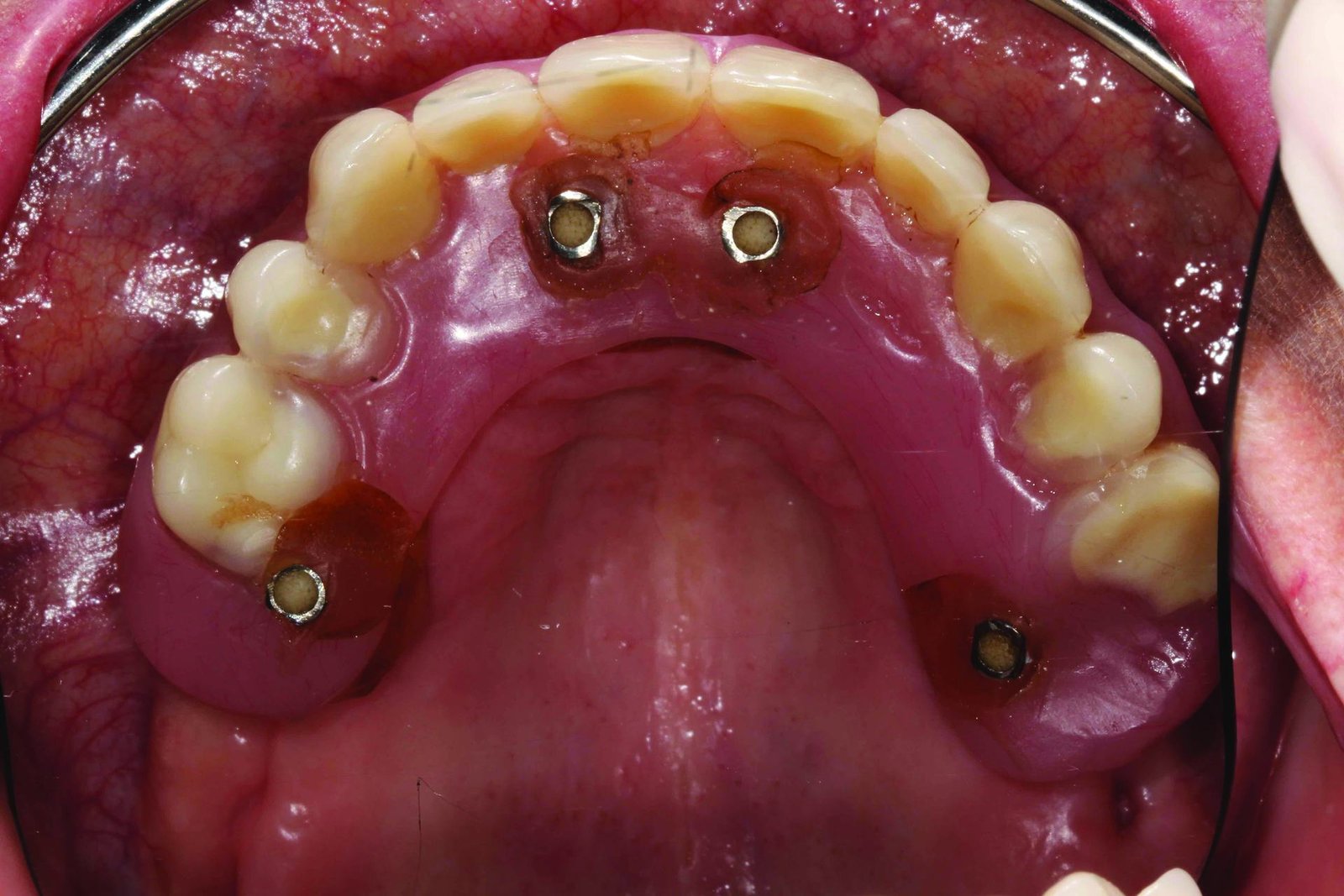
Figure 7: Provision prosthesis occlusal view

Choosing the best option
When choosing a prosthetic solution, there are several pertinent decisions to be made:
- Screw access trajectory — ideal versus non-ideal
- Restorative space — acrylic versus ceramic
- Opposing occlusion — natural, denture or implant
- Arch — maxilla or mandible
- Force — high or low
- Speech — possible adaptation challenges
- Oral hygiene — commitment to preventive care
- Esthetic demand — high or low
- Cost
As the screw-access trajectory would not be ideal here, multi-unit abutments would be needed to ensure a screw-retained prosthesis. Vertical space would therefore need to be created. The sites would need to heal, and thus, the situation was not ideal for immediate implant head placement. Because of this, an acrylic superstructure was decided upon, to ensure good “pink and white” esthetics. The opposing dentition was mixed restoratively, and therefore, suitable for the less abrasive acrylic. Forces were judged to be moderate from the failed dentition’s mild tooth wear.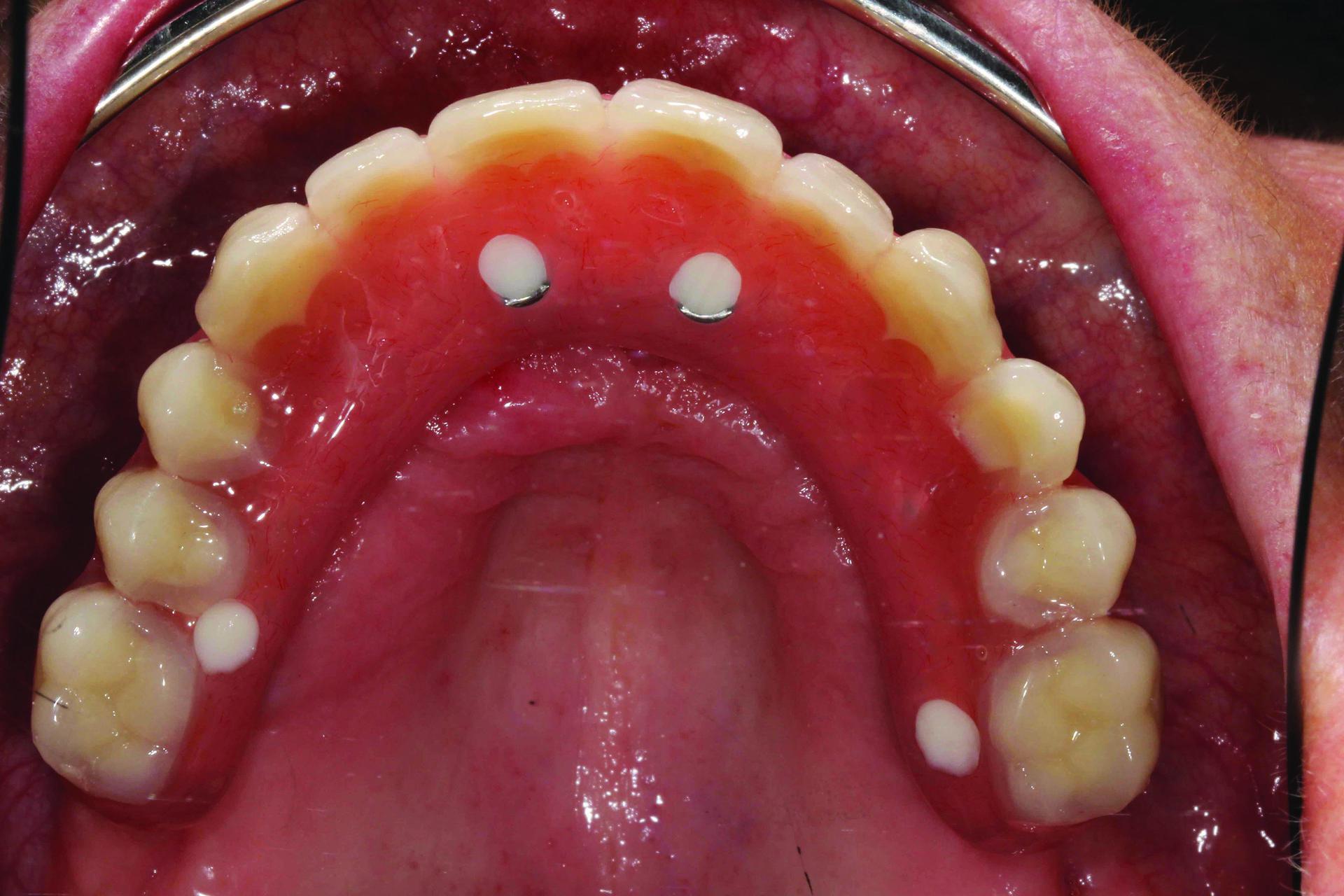
Figure 10: Final occlusal view
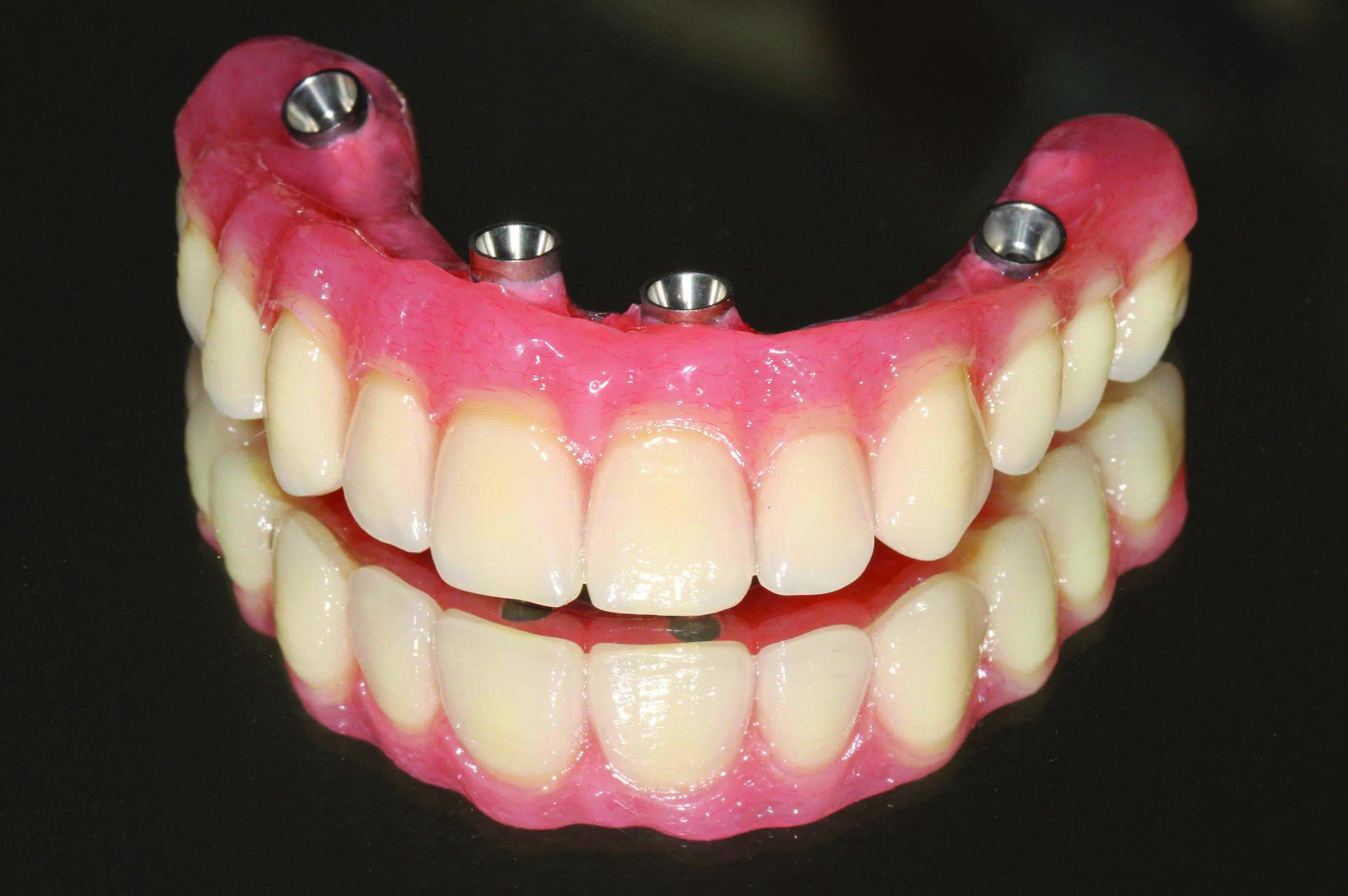
Figure 11: Final prosthesis
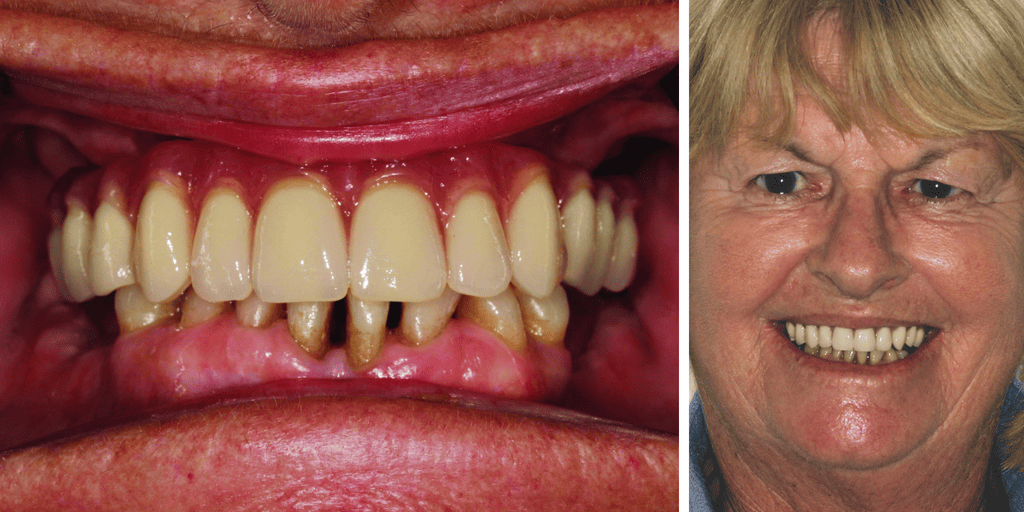
Figure 12: Final retracted view Figure 13: Final smile
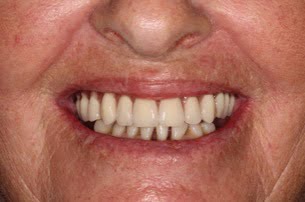
Figure 14: Final smile
Treatment
In November 2015, following smoking cessation, extensive oral hygiene instructions, and periodontal treatment, all of the patient’s upper teeth were removed. The sockets were debrided and all granulation tissue removed to ensure only healthy bone was remaining.
Distal implants (BioHorizons tapered internal Laser-Lok® 4.6 mm x 12 mm) were strategically used following planning from a CBCT scan to utilize anterior-posterior spread and avoid the sinuses. Anterior implants (BioHorizons tapered internal Laser-Lok 3.8 mm x 12 mm) were placed beyond the apex of the original teeth (following bone reduction), utilizing deeper bone and creating space for the restorative components. To improve the emergence profile of the implants, 17 multi-unit abutments were torqued at 35Ncm. Titanium cylinders were then fitted at 15Ncm to bond to an acrylic denture with cold-cure acrylic.
The dental technician (Michael Allison of Gordon Watters Laboratory) attended on the same day and assisted with the pickup of the acrylic denture and reformation of it to a neater, more comfortable prosthesis. The fixed denture was torqued at 15Ncm, screw access holes were protected by PTFE tape, and sealed with Fuji IX.
The patient was instructed to stick to a soft diet for 2 months and to use chlorhexidine-based PerioKin® gel and Kin® gingival mouthwash (Kin) to assist with antibacterial cleaning. The patient was then left to heal for 2 weeks, after which the sutures were removed and the healing process checked. This was left for a further 3 months to allow for healing maturation and osseointegration to take effect.
Following 3 months of osseointegration, impressions were taken of the existing bridge in situ, as well as a special open tray impression with Heraeus Kulzer putty, plus a wash impression of the multi-unit copings. The patient was restored definitively in March 2016 and has attended the hygienist every 3 months since placement. The bridge will be removed annually for a deep clean by the hygienist.
In between appointments, the patient uses a Waterpik® Complete Flosser twice-daily to clean effectively. The patient has reported greatly improved comfort during function, and her confidence has increased dramatically.
TeethXpress is a biomech-anically stable, immediate load, and function protocol for fully or partially edentulous patients that use BioHorizons tapered implants with Laser-Lok technology to provide primary stability for imme-diate load. More information is available from BioHorizons (www.biohorizons.com).
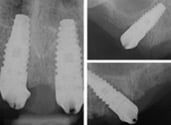
Figure 15: Radiographs of osseointegrated implants
References
- Belivacqua M, Tealdo T, Menini M, et al. The influence of cantilever length and implant inclination on stress distribution in maxillary implant-supported fixed dentures. J Prosthet Dent. 2011;105(1):5-13.
- Brunski JB. Biomechanical aspects of the optimal number of implants to carry a cross-arch full restoration. Eur J Oral Implantol. 2014;7(suppl 2):S111-S132.
- McGrath C, Bedi R. Population based norming of the UK oral health related quality of life measure (OHQoL-UK). Br Dent J. 2002;193(9):521-524.
- McGrath C, Bedi R. Measuring the impact of oral health on quality of life in Britain using OHQoL-UK(W). J Public Health Dent. 2003;63(2):73-77.

 Dr. David Murnaghan qualified from Queen’s University Belfast in 2006. He completed a year-long implant certificate in 2007 and also holds an advanced esthetic dentistry certificate from the Eastman UCL. He became a member of the Joint Dental Faculties RCS (Eng) in 2010. Dr. Murnaghan is director of the Northern Ireland Division of the Faculty of the Royal College of Surgeons England. In 2012, he set up Boyne Dental and Implant Clinic, which was voted Best New Practice in Ireland 2016. He has been mentoring local practitioners within the implant field for over 5 years. Dr. Murnaghan won the Rising Star award at the Irish Dentistry Awards 2017.
Dr. David Murnaghan qualified from Queen’s University Belfast in 2006. He completed a year-long implant certificate in 2007 and also holds an advanced esthetic dentistry certificate from the Eastman UCL. He became a member of the Joint Dental Faculties RCS (Eng) in 2010. Dr. Murnaghan is director of the Northern Ireland Division of the Faculty of the Royal College of Surgeons England. In 2012, he set up Boyne Dental and Implant Clinic, which was voted Best New Practice in Ireland 2016. He has been mentoring local practitioners within the implant field for over 5 years. Dr. Murnaghan won the Rising Star award at the Irish Dentistry Awards 2017.

